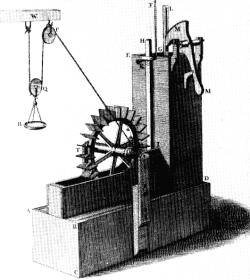These sections cover:
Water wheels are a class of old machines which were developed since 2000
years. The first account of a water wheel combined with a bucket chain was
given by Philon of Byzanz.
***image***
Philon's self-containing machine to pump water to
a higer level. Although the idea of closing the loop
an thus inventing a perpetual motion machine seems
to be obvious, Philon gives no hint to this notion.
In classical machine construction, water wheels are characterized by a horizontal
axis. We basically can distinguish 3 types of water wheels.
 |
The undershot water wheel
This type is the oldest. Vitruv described that type of water wheel in the
1st century B.C. It can be used wherever a swiftly running river is available.
Its efficiency is around 25% In the 19th century, this type of wheel was
further develeped. Especially the design by Poncelet reached an efficiency
of 70%. |
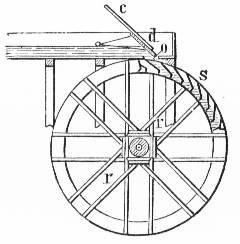 |
The overshot water wheel
Overshot water wheels are in use since the 14th century. If they are well-made
and the height of the upper water reservoir allows a large diameter of the
wheel, an efficiency up to 75% or sometimes even 80% is possible. |
 |
The center water wheel
This is the most recent type, being developed in the 16th century. It is
a compromise between the two basic constructions. Older versions had up to
45% efficiency, modern types can reach up to 75% efficiency. |
The typical construction element of water turbines is a vertical axis. The
first wheels of this kind were invented and depicted in the late sixteenth
century. Due to the shape of the shovels, they sometimes are called spoon
wheels. The development of the modern water turbines began around 1820.
1824, the expression turbine was coined by the french engineer Claude
Bourdin.
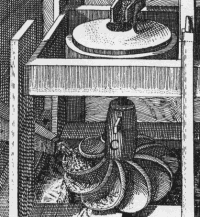 |
This type of water wheel with vertical axis dates back to the end
of the sixteenth century. The earliest design I could figure out is this
one by Giovanni Branca. The construction element was used by Jacopo Strada
for a recirculation mill which thus became the first PMM with a water turbine.
Later, Andreas Boeckler recycled the idea in the mid-seventeenth century. |
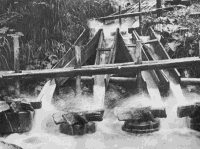 |
In places were swiftly running water is abundant, even primitive turbines
survived until the twentieth century like these in the austrian Alps. Their
efficiency is bad, but sufficient enough for the purpose, which in this case
is grinding of marbles. |
 |
Modern turbines, like this disassembled Francis turbine (around 1880)
have high efficiency of 80%, sometimes up to 90%. |
Other Water engines
yyy
Systematic Research on Water
Engines
In the second half of the 18th century, first systematic research was made
to learn how water wheels worked and how to improve their efficiency by a
suitable design. The epoch is characteristic for the beginning of the industrial
revolution. We have to keep in mind, that James Watt also made his reasearch
work on steam engines at that time.
The task to improve water wheels was not only caused by scientific interest;
but rather a commercial issue which made good energy sources crucial for
a flourishing manufacturing industry.
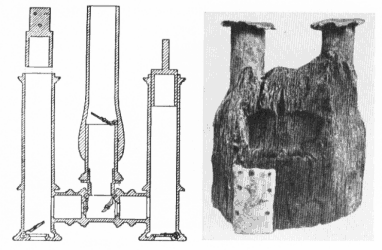 |
|
Piston pumps are a roman invention. They date back to 250BC. Authors
like Vitruv and Heron of Alexandria give descriptions of pumps and other
mechanisms whose function is based on cylinders and pistons. |
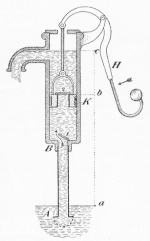 |
|
Classic sucktion pumps only work, if water is to be pumped up less than
approx. 10m (=33ft). In ancient times, this effect was explained by Aristotle's
horror vacui i.e. nature abhors vacuum. It took until the
mid-seventeenth century until Evangelista Torricelli, a pupil of Galileo
Galilei found the correct explanation. |
The Archimedian Screw
The Archimedian screw is a very old type of pump. Researchers today think
that the name is appropriate, as it can be tracked back until around 250BC.
It was known in ancient greece and rome and even today has great practical
value although most people are not aware of it, as the principle often is
concealed in machine housings. Archimedian screws are used to lift water
for irrigation purposes. As the device works continously, it can be operated
in an easier manner than an piston pump with its intermittent working cycle.
In ancient times, turning pumps used to be slaves' labour. Until recent,
archimedian screws were in use in the middle east.
 |
|
 |
| A cross-section through an Archimedian screw |
|
Irrigation in Egypt around 1950 |
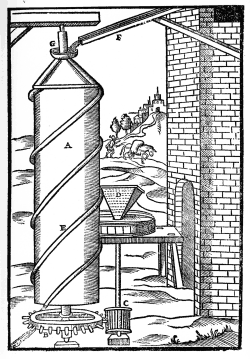 |
|
The principle of the Archimedian screw can also be utilized to win mechanical
energy. Often, the idea is attributed to Giovanni Branca, who described 1629
a predecessor of today's water turbines. In fact, Leonardo da Vinci made
the same suggestion already around 1490. He used the principle for a
perpetual motion machine! |
***image***
The hydraulic ram
The hydraulic ram was invented by Etienne Mongolfier, who was one of the
famous Montgolfier Brothers who made the first successful tests with a hot
air balloon. The hydraulic ram is a remarkable machine, as it can lift water
higher than the running water flow which is used to power the machine. This
sounds paradox at the first glance and seems to open a loophole for recirculation
mill construction, but the first law of thermodynamics demands its tribute.
However, one patent is known to me that suggested the hydraulic ram as central
element of a recirculation mill.
***image***
xxx: French patent no. xxxxxx.
Other Types of Pumps
***image***
A ball-pump by Georg Agricola
The Hydrovolve Engine
This chapter is based on two books which both were published around 1920
in Germany. I were not sure where to put this chapter: here or into the
Illustrated Historical Magazine of not so useful
inventions.
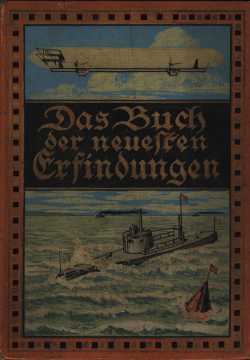 |
|
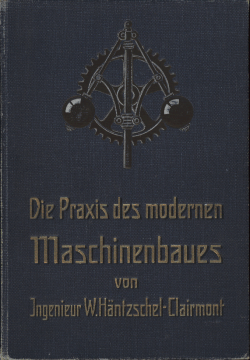 |
Das Buch der neuesten Erfindungen
(The Book of Most Recent Inventions) |
|
Der neuzeitliche Maschinenbau
(Modern Machine Construction) |
The hydrovolve engine is a german invention which is no PMM at all, but an
interesting technical concept with interesting flaws. The principle is based
on an overshot waterwheel which powers a locomotive. The wheel is fed by
an overhead canal which runs parallel to the railway tracks.
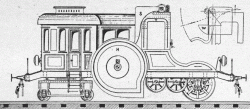 |
Side view of a traction locomitive |
 |
Front view of two traction locomotives running in opposite directions |
 |
An experimental locomotive driven by a hydrovolve engine |
 |
The shape of the inner and outer turbine blades. The construction idea
is a combination of an overshot whater wheel and a radial turbine. The shape
of the blades shall provide the best possible usage of the streaming water
power. |
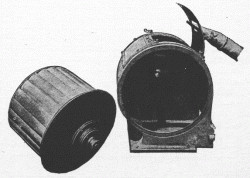 |
A disassembled hydrovolve engine |
By looking at these machines, some questions arise:
-
where runs the waste water? Isn't there the risk of flooding the rails and
damaging the underground construction by large amounts of water running into
it?
-
Can the locomotive run uphill?
-
Why did the inventor not arrange the railway tracks in parallel terraces?
Thus the lower locomotive could use the waste water from the upper machine
-
How is constant water supply provided?
-
How is high power at low speed obtained? This is important for traction engines
when the train has to start running.
-
How will a railway switch look like?
-
What is the power a locomotive of this type can deliver? Is it worth to follow
this idea?
The last question gives an insight into the mindset of the inventor. He writes:
yyy
The combined use of siphon effect and turbine/waterwheel shall give the expected
power. If we consider the potential energy of the water, and assume that
this is converted by 100% into kinetic energy which is transferred by 100%
to the locomotive's wheels, we can calculate this example:
-
locomotive speed: 20m/s
-
cross-section of the inlet: 0,5m * 1m = 0.5m2. If wee look at
the drawings, this seems to be an optimistic estimate
-
without losses, a consumption of 0.5m2 * 20m =
10m3/s is possible
-
height 4m
-
P = (10000kg/s) * 4m = 40000kgm/s = 40kW
which are around 55hp. Compared with the several thousand hp, a standard
locomotive provides, this seems to be a rather poor result. But stop! What
about the dynamics? If the locomotive runs along the upper canal, the water
is forced into the guiding tube to the turbine. Moreover, the siphon effect
should add power.
My first guess is: that seems to be misleading.
-
There is the siphon effect, but moving water to the same level will give
no additional power. Thus the height of the siphon has no influence on the
power generated by the machine.
-
It's right, the water is forced into the tube, but it has to be guided, so
there will be a force acting into the opposite direction of the vehicle.
The power provided by the machine is independent from the speed of water,
as the amount per total height is important.
-
It should not matter if the water runs through a thin tube at high speed
or a thick tube at low speed.






